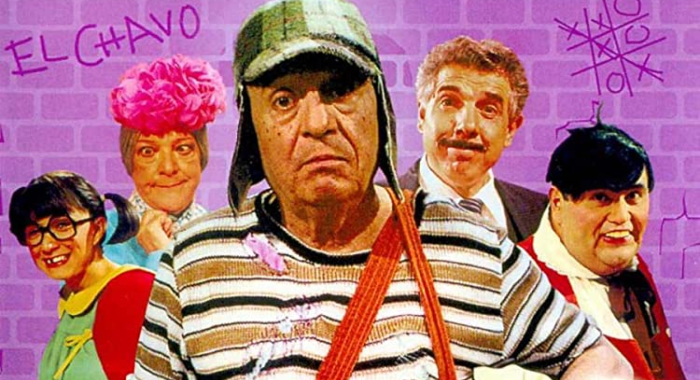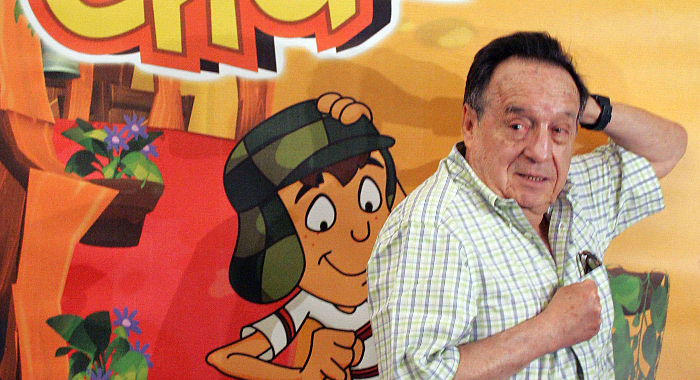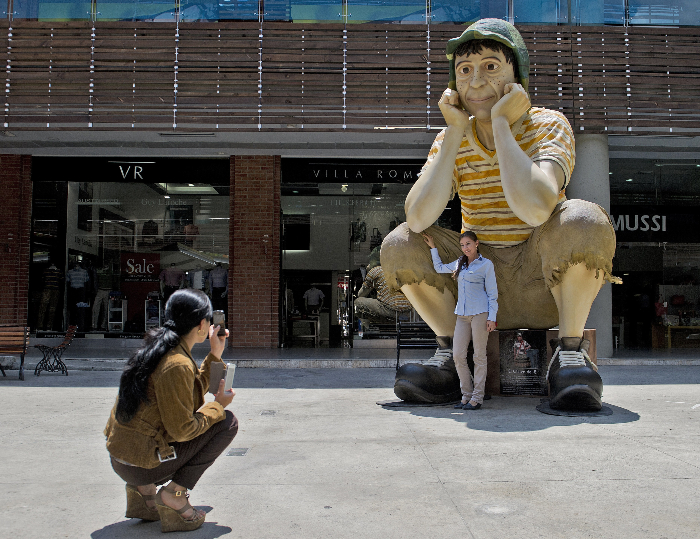TAGGED AS: Comedy, hispanic, sitcom, spanish language, TV

(Photo by Xenon)
Of the legion of comedic characters penned – and in many cases also played – by the late Mexican entertainment wizard Roberto Gómez Bolaños, better known as “Chespirito,” his most widely beloved are those who feature in El Chavo del Ocho, an iconic pillar of Latino pop culture.
First aired in the early 1970s on Televisa, the Mexican media empire behind all of Chespirito’s shows and which later distributed them internationally, the sitcom rapidly achieved stratospheric popularity across Latin America; at the height of its success it reached an average of 350 million viewers per episode. Long in syndication in many countries, including the United States via Univision’s channels, the show continues to enjoy a vast multigenerational fanbase half a century later. Its impact among Latinos in the U.S. is such that in 2016 the city of Los Angeles declared September 8 as “El Chavo del Ocho Day.”
Why is the series and its creator so peerlessly cherished among Latinos? With El Chavo del Ocho, Chespirito gifted us a story that communicates across ages, income levels, and even borders – all via the unifying power of hilarity.
Dressed in worn-out khaki pants, a striped shirt, suspenders, and a tartan hat with earflaps, the title character of El Chavo del Ocho, El Chavo, is a young and poor orphan whom the neighbors assume lives in a barrel in the courtyard of a working-class apartment complex, or “vecindad.” As with all the child roles in the show, El Chavo is played by an adult, Chespirito himself, who leans into the character’s kindheartedness and mischievousness.
There’s an underlying sadness to El Chavo’s circumstances and history of abandonment, which Chespirito doesn’t entirely shy away from (there are touching moments throughout the series’ numerous episodes), but it is infused with humor, much of it drawn from the character’s interaction with the neighbors who come to tacitly adopt him. Part of the show’s brilliance lies in the creation of these supporting personalities with whom Chespirito populates El Chavo’s world. Each of them was sharply drawn and had their own catchphrases that have become ingrained in the Mexican and Latin American vernacular. Over the years, the cast became almost inextricable from their parts.

Stamps made to commemorate Bolaños’s characters, El Chavo and Chapulin Colorado. (Photo by SUSANA GONZALEZ/AFP via Getty Images)
There’s La Chilindrina (María Antonieta de las Nieves), a freckled and astute girl who knows how to manipulate her father Don Ramón (Ramón Valdés), a grumpy middle-aged and out-of-work scoundrel; Quico (Carlos Villagrán), a spoiled brat whose big cheeks impede his speech; his uptight and hair-rollers–wearing mother Doña Florinda (Florinda Meza); and her love interest El Profesor Jirafales (Rubén Aguirre), an elementary school teacher whose last name alludes to his giraffe-like lankiness.
With its endearing relationships and absurdist shenanigans, El Chavo del Ocho amused audiences across the socioeconomic strata. However, it was particularly relatable to those of us of with low-income upbringings. We saw Quico getting a slew of wonderful toys for Christmas, while La Chilindrina had a single doll and El Chavo spent the holiday empty-handed. We then cheered as our hero took every opportunity he could to get his hands on food, especially if it was a ham sandwich (torta de jamón), because he didn’t know when his next meal would be.
While the social classes of the characters, and the nuanced differences of circumstances between them, are made evident and form part of the mechanics of the story, El Chavo and his struggling neighbors had a sense of pride. In fact, a lot of the gags come from these individuals not allowing themselves to be undermined or humiliated by those with more resources, like Doña Florinda. She doesn’t mince words when it comes to her disdain for the others and advises Quico to “not hang out with the riffraff ” – or as she would say it, “la chusma.”
Although the show’s conflicts are necessary for its comedy, no one is rendered totally villainous, not even Doña Florinda. Compassion and solidarity lie at the core of El Chavo del Ocho. This group of people don’t always see eye-to-eye, but when it counts they are willing to help out each other. Their disputes never devolve to cruelty or malice, and they are just as quick to forgiveness as they are to anger. It’s a community tied to a place, “la vecindad,” and therefore to each other. As hilariously obnoxious as Quico can often be, he ultimately sees El Chavo as a friend.

Bolaños at the launch of the animated El Chavo series. (Photo by LUIS ACOSTA/AFP via Getty Images)
This almost familial unity is perhaps best seen in those moments when the residents collectively express frustration towards the hero’s antics. “It had to be El Chavo del Ocho,” they say. To which El Chavo replies, “You don’t have patience with me.” It’s a funny exchange, but it also speaks to the neglect he’s grown accustomed to and to the fact that his fellow tenants are familiar with his recklessness and still love him – even if they rarely say it out loud. Chespirito knew how to grapple with pathos in a way that felt endearing but still got plenty of laughs.
The indelible slang and curious names associated with Chespirito’s work, much of it from El Chavo del Ocho, are an integral part of his legacy. Whenever a silly plot or imaginative adventure ended with an unfortunate result – which was, well, often – El Chavo would utter, “Se me chispoteo” (“I messed up”). Today, that line remains highly identifiable among millions of Spanish speakers across the Americas. Other highlights in the creator’s extensive vocabulary using “ch” include: “Chompiras,” the aforementioned “chusma,” “Chimoltrufia,” or “chipote chillón.”
Beyond the catchphrases and slang, the show’s thematic elements are largely universal and appreciated by audiences of all stripes and ages. There are themes that will ring familiar to Western audiences – the house at the end of the street that no one wants to go near; there is slapstick humor and wild adventures that appeal to the young; and sophisticated social commentary that appeals to more mature viewers.

A statue of El Chavo by an anonymous artist, in Colombia, 2014. (Photo by LUIS ACOSTA/AFP via Getty Images)
In the mid-2000s, Televisa launched an animated incarnation simply titled El Chavo Animado. Legal issues related to María Antonieta de las Nieves’ ownership of the character prevented La Chilindrina from being part of this project, but all other emblematic members of the gang got the 2-D treatment. With 134 episodes capturing the essence of the property for a younger generation, the animated series ensured the El Chavo legacy lived on even longer.
For many Latinos, watching El Chavo del Ocho is one of those intangible keepsakes, a tradition even, passed down from grandparents to parents and so on for the last several decades. For Latino immigrants in the U.S. the show has undoubtedly been a slice of comfort calling back to their homelands, while for their American-born and raised children and grandchildren, El Chavo and co. are a bridge to their heritage.
The show’s perpetual availability on network television – until recently, at least – enabled such cultural permeation, but it’s the quotable cleverness, wrapped in a family package, that hooked us. Through the hysterically flawed humanity Chespirito put on screen, he allowed us to bond with each other, and across generations, through laugher tied to a certain pureness of spirit. As far as mass-appealing art goes, El Chavo del Ocho, like few other works, has earned its legendary timelessness by way of its giant and open heart.
Looking for more to celebrate Hispanic Heritage Month?